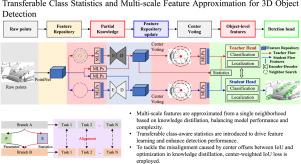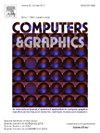Transferable class statistics and multi-scale feature approximation for 3D object detection
IF 2.8
4区 计算机科学
Q2 COMPUTER SCIENCE, SOFTWARE ENGINEERING
引用次数: 0
Abstract
This paper investigates multi-scale feature approximation and transferable features for object detection from point clouds. Multi-scale features are critical for object detection from point clouds. However, multi-scale feature learning usually involves multiple neighborhood searches and scale-aware layers, which can hinder efforts to achieve lightweight models and may not be conducive to research constrained by limited computational resources. This paper approximates point-based multi-scale features from a single neighborhood based on knowledge distillation. To compensate for the loss of constructive diversity in a single neighborhood, this paper designs a transferable feature embedding mechanism. Specifically, class-aware statistics are employed as transferable features given the small computational cost. In addition, this paper introduces the central weighted intersection over union for localization to alleviate the misalignment brought by the center offset in optimization. Note that the method presented in this paper saves computational costs. Extensive experiments on public datasets demonstrate the effectiveness of the proposed method. The code will be released athttps://github.com/blindopen/TSM-Det-Pointcloud-.

三维目标检测的可转移类统计和多尺度特征逼近
研究了多尺度特征逼近和可转移特征在点云目标检测中的应用。多尺度特征是点云目标检测的关键。然而,多尺度特征学习通常涉及多个邻域搜索和尺度感知层,这可能会阻碍实现轻量级模型的努力,并且可能不利于受有限计算资源约束的研究。本文基于知识蒸馏,从单个邻域逼近基于点的多尺度特征。为了弥补单个邻域中建设性多样性的损失,本文设计了一种可转移的特征嵌入机制。具体来说,考虑到较小的计算成本,类感知统计被用作可转移的特征。此外,本文还引入了中心加权交优于联合的定位方法,以缓解优化过程中中心偏移带来的不对准问题。值得注意的是,本文提出的方法节省了计算成本。在公共数据集上的大量实验证明了该方法的有效性。代码将在https://github.com/blindopen/TSM-Det-Pointcloud-发布。
本文章由计算机程序翻译,如有差异,请以英文原文为准。
求助全文
约1分钟内获得全文
求助全文
来源期刊

Computers & Graphics-Uk
工程技术-计算机:软件工程
CiteScore
5.30
自引率
12.00%
发文量
173
审稿时长
38 days
期刊介绍:
Computers & Graphics is dedicated to disseminate information on research and applications of computer graphics (CG) techniques. The journal encourages articles on:
1. Research and applications of interactive computer graphics. We are particularly interested in novel interaction techniques and applications of CG to problem domains.
2. State-of-the-art papers on late-breaking, cutting-edge research on CG.
3. Information on innovative uses of graphics principles and technologies.
4. Tutorial papers on both teaching CG principles and innovative uses of CG in education.
 求助内容:
求助内容: 应助结果提醒方式:
应助结果提醒方式:


